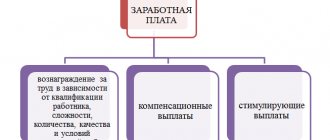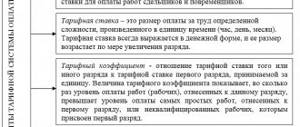Tariffication - an economic planning tool designed to combine the staffing table and employees directly occupying the rates.
This form is quite different from the standard one provided in the delivery of the configuration Salaries and personnel of a government institution, edition 3.1 .
The form looks cumbersome only at first glance. With some work with it, everything falls into place and the indicators are calculated using simple arithmetic operations.
However, there are a number of features without which it will not be possible to create a tariff list .
For example, the number of employees on staff at a medical institution can number in the thousands; and the same job titles contain different indicators depending on the division of the organization or a number of characteristics, such as the harmfulness inherent in a particular line of the staffing table.
Using the checksums of the tariff , you can easily control the occupancy of the staffing table. In addition, the tariff list includes key percentages of bonuses for length of service (both length of service and length of continuous work) and other bonuses of a qualifying and compensatory nature.
MedTarification is generated when the “History of staffing changes is maintained” setting is enabled.
The Types of Experience directory should contain the following values:
- Code : 000000001; Name : Allowance for continuous work experience (in healthcare);
- Code : 000000007; Name : Longevity of service (in the budget);
- Code : 000000010; Name : Allowance for continuous work experience (in ambulance);
- Code : 000000011; Name : Allowance for continuous work experience (at the site);
For the report to work, there is no need to edit the configuration, but you need to add some additional details and information.
Additional details
Positions
Name : Tariff list form
Value type : Additional value
Values : Form No. 1, Form No. 1-O219, Form No. 4, Form No. 4-O219
For example, for the position “Nurse” the additional details will look like this:
Name : Personnel code
Value type : Additional value
Values: 1, 2, 3, 4, 5, 6, 8, 24, 40, 48
Employees
Name : Category of employees
Value type : Additional value
Values : Highest, First, Second
The purpose of tariffication is to establish tariffs (prices) for relevant types of work and operations, which allows organizing work to determine the amount of remuneration for employees of the enterprise.
The tariff system usually covers workers and employees of the enterprise, but is developed separately for different categories of workers.
The main components of tariff conditions of remuneration for separate development for workers and employees are [13, p. 127]:
· the minimum wage rate for an employee as the basis for calculating tariff rates and official salaries of employees;
· tariff rates of the first category, differentiated by the main tariff-forming factors (labor intensity, types of work, working conditions) and forming the so-called vertical of first category rates;
· tariff rates for categories of workers, differentiated by the complexity of the work they perform (workers’ qualifications) and forming the so-called horizontal rate scale, or tariff schedule;
· salary schedules for employees, including managers, specialists, etc., built taking into account the complexity of the job responsibilities they perform;
· tariff and qualification directories of jobs and professions of workers, qualification directories of positions of managers, specialists and employees, or corresponding descriptions of work at the enterprise, as tools for tariffication of workers and employees.
An enterprise can independently carry out work on the tariffs of workers and employees, but usually the Unified Tariff and Qualification Directory of Work and Professions of Workers (UTKS) is used for these purposes. In addition, familiarity with the methods used in ETKS can help build a rational wage system at the enterprise.
Practice shows that many enterprises use differentiation of tariff rates of the first category according to the following three main characteristics (tariff-forming factors) [13, p. 130]:
1. By forms of payment: tariff rates of the first category are applied for piece workers (higher) and time workers.
2. By individual professional groups: for example, groups with increased labor intensity are distinguished (machine operators, assembly line workers); with increased responsibility associated with working with special technical equipment (workers on high-performance machines and units).
. According to the conditions of labor severity: tariff rates increase by a certain percentage if the conditions and severity of labor in the workplace deviate from normal.
These signs of differentiation of rates can be accepted by the enterprise in full, in part, or replaced by others arising from its specifics.
The tariff schedule is the ratio of tariff rates by category.
According to the ETKS of works and professions of workers, for example, the vast majority of workers are “tariffed” according to 6 main categories. In other words, ETKS provides a 6-bit grid with a ratio of rates of the outermost digits of 1:1.8.
For a limited range of work in mechanical engineering, mainly in the production of ferrous metallurgy, in the extraction of raw materials for ferrous metallurgy, for some work in the electric power industry, two additional categories of tariffication of work and workers are used - the seventh and eighth, the use of which expands the range of differentiation of tariff rates to 1:2.
The inter-bit ratios of tariff rates in the 8-bit grid are (Table 1.1)
Table 1.1 - Inter-digit relationships
| Tariff categories | 1 | 2 | 3 | 4 | 5 | 6 | 7 | 8 |
| Tariff coefficients | 0,000 | 1,008 | 1,204 | 1,350 | 1,531 | 1,800 | 1,892 | 2,000 |
| Absolute increase in tariff coefficients, units. | — | 0,088 | 0,116 | 0,146 | 0,181 | 0,269 | 0,092 | 0,108 |
| Relative increase in tariff coefficients, % | — | 8,8 | 10,7 | 12,1 | 13,4 | 17,6 | 5,1 | 5,7 |
Pages: 1
see also
A systematic approach to enterprise management...
Development of a standard for the personnel certification system of the enterprise OJSC Khabarovsknefteprodukt Introduction Productivity, qualifications, competence, diligence and loyalty of employees are important prerequisites for the success of enterprises. Guide installation to their d...
Development of recommendations for improving the competitiveness of an enterprise in the market (using the example of LLC NZZhBI named after Ivanov G.S.) Introduction Currently, market relations dominate in any country in the world. There are now a huge number of companies producing homogeneous products. There is a tight race between them...
additional information
Accruals
Name : Identifier for tariffing
Value type : Additional value
Values : Base for experience, Harmfulness, Length of service, Qualification, Badge, Continuous work, Ambulance, District, Academic degree
Performance tested on configurations : Salaries and personnel of a government agency, edition 3.1 (3.1.3.157-3.1.3.273);
Platform from 1C:Enterprise 8.3.10.2252
Normative base
Legal regulation of the assignment of rank at an enterprise is carried out through the ETKS, which are contained in Decree of the USSR State Committee for Labor dated January 31, 1985 No. 31/3-30. Let us remind you that ETKS is the Unified Tariff and Qualification Directory of Work and Professions of Workers.
An additional basis for management when considering questions about the initial establishment or change of an employee’s rank is:
- EKS from the Resolution of the Ministry of Labor dated 08/21/1998 No. 37;
- professional standards that have been put into effect by the Ministry of Labor, if a standard exists for a specific position.
The level of remuneration depends on the qualification tariff, which is directly related to the degree of complexity of the work tasks performed.
Versions
Obfuscated external report "MedTarification" - old version of the report. Although it contains some errors and does not provide source code, it provides the most accessible way to evaluate the report's performance. Not supported.
Open source extension “MedTarification v1.0” is an open source report. Some bugs have been fixed. The link is displayed in the “Personnel” subsystem.
Open source extension “MedTarification v2.0” - available only by subscription. The formation speed is increased by 2.5-3 times depending on the volume of data. Fixed errors with duplicating lines and displaying fired employees. The comparison of types of length of service and accruals is placed on a separate settings page. Has its own demo page with the formation of Form No. 1.
Tariffing of works and workers
Tariff regulation of wages
Essence, purpose and main elements of the tariff system
Tariffing of works and workers
Tariff schedules, their purpose and construction
Tariff rates
Calculation of average tariff values
Additional payments and allowances to tariff wages
Essence, purpose and main elements of the tariff system
Tariff regulation is a way of managing the organization of remuneration by establishing absolute sizes and quantitative ratios of remuneration for labor of varying quality. The instrument of tariff regulation of wages is the tariff system.
The tariff system is a set of regulatory materials intended to regulate and differentiate the remuneration of workers in accordance with its quality
.
The quality of labor is understood as its complexity, significance, production, technical, natural, climatic and economic conditions for its implementation, and the qualifications of workers. These characteristics of labor and the conditions for its implementation are called tariff-forming factors
(Fig. 1).
Rice. 1. Quality of labor (tariff-setting factors)
Work of different quality should be paid differently. The establishment of quantitative differences in wages of different quality is the essence of wage differentiation. The means of differentiation is the reduction of labor.
In relation to labor, the concept of reduction is used in the narrow and broad sense of the word. In the narrow sense of the word, labor reduction is the reduction of complex labor to simple labor or the expression of the amount of complex labor in simple units taken as a standard. In the broad sense of the word, labor reduction means the reduction of all qualitative differences
in labor to its quantitative differences. For example, one hour of labor of a highly skilled worker is equivalent to two hours of labor of an unskilled worker; one hour of labor in unfavorable production and technical conditions is equivalent to 1.24 hours of labor of a worker of the same qualifications in normal conditions.
Labor reduction is carried out using reduction coefficients
, showing how many units of labor, taken as the standard, are contained in labor included in a particular tariff group.
In the practice of organizing wages, the most common types of labor reduction coefficients are tariff coefficients
,
percentages (coefficients) of increasing pay for working conditions
that deviate from normal,
regional coefficients
. Labor reduction can also be carried out by establishing absolute differences in payment for a unit of labor of different quality or using a variety of additional payments and allowances to pay for higher quality work.
All the tools with the help of which labor reduction is carried out are elements of the tariff system and in their totality constitute its content (Fig. 2).
Rice. 2. Main elements of the tariff system
Tariff and qualification reference books are the basis for assigning work to various complexity groups, and workers to various qualification groups. Tariff schedules and regional coefficients establish labor reduction coefficients based on complexity and some other characteristics. Tariff rates, surcharges and allowances establish absolute sizes and differences in remuneration for labor of different quality.
According to Article 143 of the Labor Code of the Russian Federation, tariff systems of remuneration are established by collective agreements, agreements, local regulations in accordance with labor legislation and other regulatory legal acts containing labor law norms[1].
Tariffing of works and workers
Before establishing quantitative relationships in remuneration for labor of varying complexity, it is necessary to distribute all work into groups of complexity, and workers according to skill level - into tariff (qualification) categories. Tariff category is a value that reflects the complexity of work and the level of qualifications of the employee [2]. The number of categories depends on the diversity of the range of work at the enterprise, the range of their complexity, as well as on the remuneration of which categories of personnel is carried out using a given tariff schedule. Typically, if the wage scale is used only to pay workers, and managers, specialists and employees are paid on the basis of an official salary scheme, the number of ranks is limited to 6 (for certain types of work - 8). In the same case, if payment for all categories of personnel is organized on the basis of a tariff schedule (so-called unified tariff schedules), the number of categories reaches 18 or more. The first category is charged to workers of the initial (lowest) skill level and the simplest work, the last - to workers of the highest skill level and the most complex work.
The assignment of works and workers to tariff (qualification) categories is called tariffication. Tariffication of work and assignment of tariff grades to employees is carried out on the basis of the All-Russian Classifier of Worker Occupations, Employee Positions, Tariff Levels[3], taking into account the Unified Tariff and Qualification Directory of Work and Professions of Workers and the Unified Qualification Directory of Positions of Managers, Specialists and Employees.
ETKS includes 68 issues (before 1999 - 72). The first issue contains the “General Provisions of the ETKS” and tariff and qualification characteristics of “cross-cutting” professions common to all industries, and subsequent editions contain tariff and qualification characteristics of all other professions, grouped by type of work and production.
Tariff and qualification characteristics of workers' professions are given by category and consist, as a rule, of three sections: “Characteristics of work” (description of the main, most typical for a given profession and category of work and the main labor functions performed by the worker), “Must know” (statement basic requirements for the worker’s qualifications necessary for high-quality performance of work given in the first section), “Examples of work” (a list of the most typical works for a given profession and a given tariff category).
The basis for the tariffication of work when developing ETKS is the use of an analytical method for assessing the complexity of work. The essence of the analytical method is the division of the labor process into individual elements
(functions or complexity factors) common to various types of work,
and a consistent (from element to element) assessment of their complexity using a point system.
The result of the assessment - the integral indicator of complexity - is the sum of assessments for individual elements (functions or factors).
Most sections of the current ETKS are built on the basis of the use of a methodology developed in 1979 by the Institute of Labor, which involves assessing the complexity of each type of work according to three functions (calculation functions, functions of half-preparing a workplace or work, functions of conducting a work process) and the reliability factor (responsibility) in work .
Along with the tariffication of work, the tariffication of workers - the assignment of tariff (qualification) categories to them. The main criterion for charging workers is the presence of professional knowledge and labor skills necessary to perform work of the appropriate category, provided for by the tariff and qualification characteristics of the ETKS. The issue of assigning or increasing a rank based on the personal application of a worker who has undergone training, or the presentation of the head of the corresponding half-department, is decided by the qualification commission of the workshop or enterprise, which includes representatives of the administration and trade union bodies, specialists, foremen, and skilled workers. The pricing process includes testing theoretical knowledge in the specialty and assessing the practical performance of work of the corresponding category. Knowledge of work instructions, design and technological documentation, safety and labor protection rules is tested. The decision to assign a rank is documented in the protocol of the qualification commission, approved by order of the head of the organization, on the basis of which an entry is made in the work book.
The qualification characteristics of managers, specialists and employees are formulated in the Unified Qualification Directory of Positions of Managers, Specialists and Employees (USC). The EKS was developed in accordance with the accepted classification of employee positions into three categories: managers, specialists and employees. The assignment of positions to the appropriate category is carried out depending on the nature of the work primarily performed, which constitutes the content of the employee’s work (organizational-administrative, analytical-constructive, information-technical).
The qualification characteristics provided for by the CEN at enterprises, institutions and organizations can be used as normative documents of direct action or serve as the basis for the development of internal organizational and administrative documents - job descriptions containing a specific list of job responsibilities of employees, taking into account the specifics of the organization of production, labor and management as well as their rights and responsibilities.
Tariffing of managers, specialists and employees is carried out during their certification , which involves checking the employee’s qualifications, his business qualities, assessing the results achieved, independence and quality of performance of job duties, responsibility and ability for innovation, ability to organize the work of subordinates, etc.










